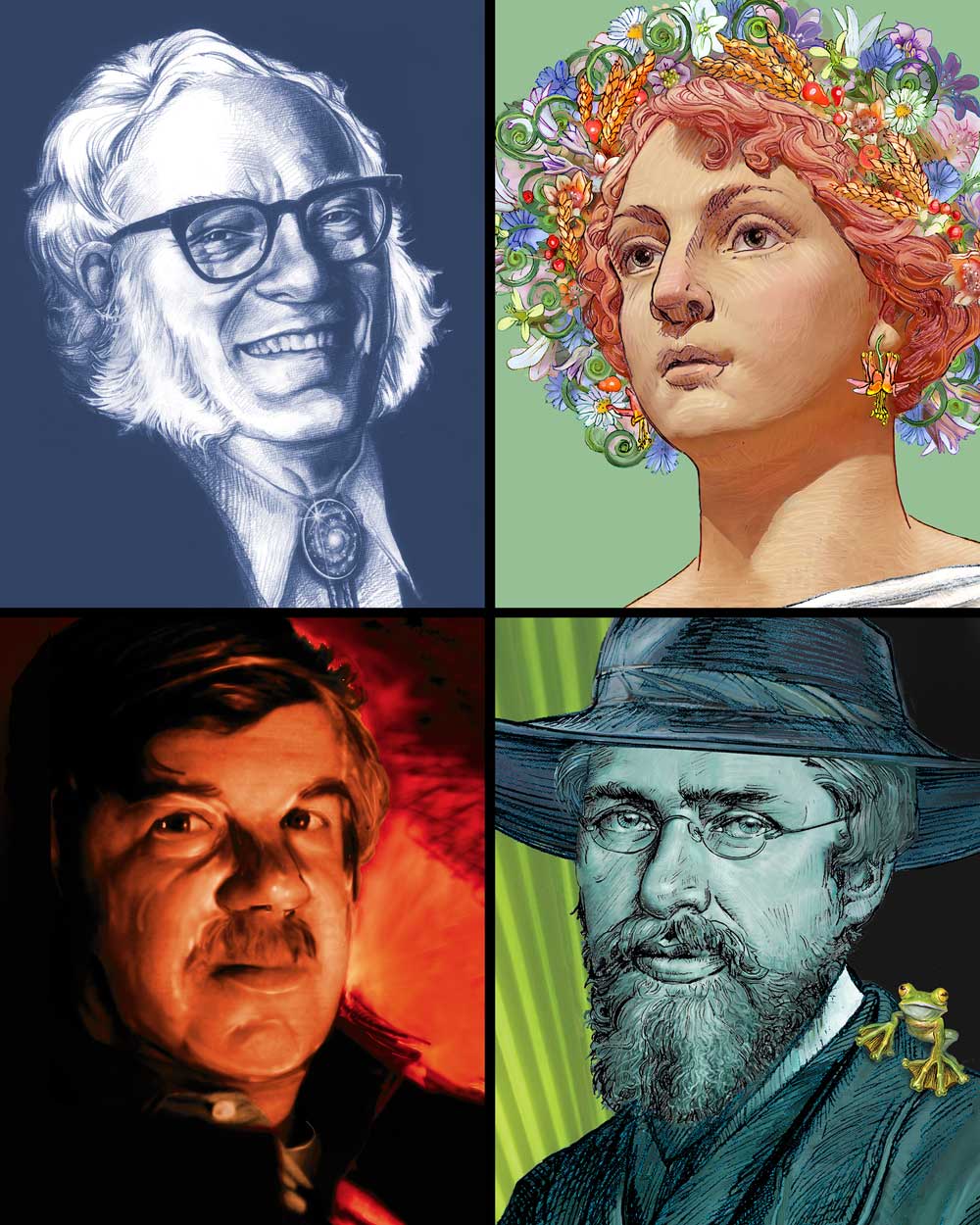Reading Room
The Art of the Skeptic
Finding Your Niche if You Love Both Science & Art
BY PAT LINSE, WITH ADDITIONAL ILLUSTRATIONS BY DANIEL LOXTON
THE ART OF PAT LINSE
Skeptic Activists & Heros
It’s always a pleasure to do a portrait honoring a skeptical activist.
Depicting the “Opposition”
My first instruction to an illustrator as Art Director of Skeptic magazine is “Please do not do a snake oil salesman.” Not only is it a terrible cliché, it is rarely an accurate representation of the individual who holds the beliefs we may be criticizing. Many supporters of non-scientific ideas are quite sincere.
Skeptic Cover Art by Pat Linse
Skeptic Cover Art by Pat Linse
Most & Least Popular
It is surprising to discover which illustrations turn out to be the most useful or the most controversial.
Buying Stock Art
As a rule I don’t use a stock image as is, not just because another publication may use the same one, but because I enjoy making them into something new that better fits my purpose.
THERE IS MORE TO BE DONE THAN JUST THE COVER ART
Illustrating for Clarity
Artists should not underestimate the importance of illustrations, graphs, and diagrams that illuminate points made by an author. A drawing can simplify an overly complex photo and highlight the important parts. Or a photo that is too blurry, bleached out, or dark can be saved by making it into a drawing.
Making a Point!
THE ART OF DANIEL LOXTON
I’ve never been much of a joiner, but when I discovered the skeptical movement in 1984, after reading and absolutely loving an article in the L.A. Times that explained the physics behind firewalking, I decided to get involved.
At the time I was working as an illustrator doing movie posters, and my broad ad agency background made me a one-stop shop for a skeptics group needing flyers, advertising, or a newsletter (in the pre-internet era). I made skeptic-specific samples of art and flyers and volunteered for local and national groups. I got a few assignments but the truth is, it’s hard to even give graphic arts expertise away. People respond to good art and design when they see it, but they are rarely motivated to seek it out.
By the time I met with Michael Shermer in late 1991 to talk about creating Skeptic I had 7 years of bottled up enthusiasm ready to dedicate to the project. He had a Ph.D. in the History of Science, he’d authored a few books, and he was running a nonprofit bicycle racing organization and publishing a magazine for its members. So between the two of us we had the expertise.
Skeptic was an all volunteer organization especially in its early years. We drummed up resources where we could. One of our biggest savings came from the desktop computer revolution. It was similar to today’s digital cameras and software that allow almost anyone to produce a video and post it on the Internet. In roughly a decade the cost of designing and typesetting a page for a publication, which had formerly taken the coordinated effort of many specialists (designer, layout artist, type spec, type house, half-tones, and paste-up artist), had gone from hundreds of dollars to zero when performed by a single volunteer on a computer.

This retrospective appeared in Skeptic magazine 25.4 (2020).
Buy the print edition
Buy digital edition
Subscribe to print edition
Subscribe to digital edition
In 2002 Daniel Loxton began donating artwork over the Internet. At the time I was writing and illustrating Junior Skeptic and looking for help. I had stacks of manuscripts but nothing suitable: too pedantic, too patronizing, too precious — everyone thinks they can write for young people but it’s not that easy.
But I noticed from Loxton’s cheerfully entertaining emails that he could write, so I asked him to give it a shot. His response stunned me. He produced a polished press-ready product: meticulously researched, beautifully written, and fully designed and illustrated. I had found the Holy Grail of non-profit employees: the do-it-all creative individual. I later learned that his early efforts to get involved in skepticism had gotten the same tepid response as mine had — he had already produced a Junior Skeptic style prototype and unsuccessfully tried to get other skeptic groups interested.
So the lesson to be learned for those who truly want to get involved is create a professional product and be persistent.
Graphic Arts Tips for Skeptic Groups
-
Buy art expertise wholesale, not retail if you can.
- Retail art: the ad agency — suitable for a large organization. Pick one that has clients with similar needs to yours. An agency specializing in beer or real estate clients may skew your projects in those directions. Meet the person you will be dealing with and ask questions about the samples they show you to find out if they can communicate art ideas without using a lot of jargon or hiding behind design snobbery.
- Wholesale art: the do-it-all individual. The Internet provides opportunities for these efficient self-starter types to hone their creative skills without having to land a job that perfectly fits their interests. Try them out as volunteers, and if you have a job opening you will have a pool to draw from.
- How trendy should your art be? For skeptical topics I lean toward somewhat conservative or realistic art styles because the articles themselves can be difficult to understand. One doesn’t need to add more mystery with overly abstract art. (By contrast when designing for the fashion or the music industry, it’s all about emotion, implication, and innuendo, so almost anything goes.) Also, art can actually clarify a complex article. For example, say an author has four points to make. Four small illustrations representing each point may be the way to go.
- Logos, branding, and names: pick the nickname. Pick the name that is short, sweet, and most of all memorable. Never pick a name or logo that needs an explanation so that people will understand how clever it is. Don’t try to find the perfect word — there is not a word in existence that doesn’t carry some baggage (for example, the word “skeptic”). This is why large companies make up names for products, and then spend millions creating a reputation for the new term. If you make something up, make sure it’s both easy to pronounce and to remember.
-
Avoid giving art assignments to someone’s love interest. When I worked in the music industry, nothing terrified the art department more than the news that the musician’s boy or girlfriend was going to be involved creating the image for the packaging. Art for your organization is not a throw away assignment for someone in the office who feels underappreciated. Your graphic look serves a “dress for success” function, creating a favorable impression, inspiring confidence in your product, and last but certainly not least, providing enjoyment.

About Pat & Daniel
Pat Linse is an award winning illustrator who specialized in film industry art before becoming one of the founders of the Skeptics Society, Skeptic magazine, and the creator of Junior Skeptic magazine. As Skeptic’s Art Director, she has created many illustrations for both Skeptic and Junior Skeptic. She is co-editor of the Encyclopedia of Pseudoscience.
Daniel Loxton was a professional shepherd for nine years before he became editor of Junior Skeptic. He illustrates and authors most of the current Junior Skeptic material. He wrote and illustrated the best selling award-winning Evolution: How All Living Things Came to Be, and the award winning children’s three book Tales of Prehistoric Life Series.
SKEPTIC App
Whether at home or on the go, the SKEPTIC App is the easiest way to read your favorite articles. Within the app, users can purchase the current issue and back issues. Download the app today and get a 30-day free trial subscription.

























